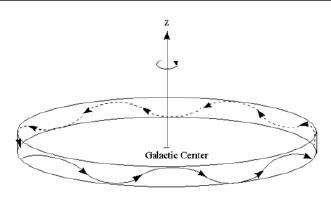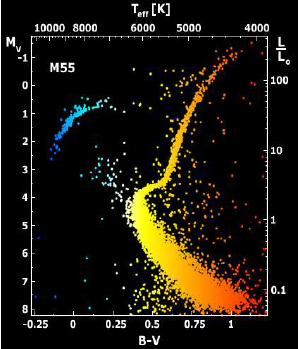Stellar "Population Types"
Stellar "Population Types"
Moving away from the solar neighbourhood, the properties of stars begin to change. A useful characterisation of these changes is called the population concept. Stars are found to broadly belong to two population types. The concept was proposed by Walter Baade in 1944. Baade noticed in studies of the nearby spiral galaxy M31 that the disk stars in M31 were like nearby disk stars in young associations in the Galaxy, while the bulge stars mere nearly resembled those of the Galaxy's globular clusters. Young, metal rich stars rotating with the disk of the Galaxy are termed Population I, while old, metal weak stars are termed Population II. The fundamental difference between these two types relates to when and how they were formed.
Population I
•The disk of the Galaxy is thought to be about 10 Gyr old. It presently contains about 20% gas by mass, and along spiral arms and in giant molecular clouds new stars are forming at a rate of about a solar mass per year. This rate is just about right to build up the disk mass over its lifetime of 10 Gyr.
The very youngest stars are of type O and B, and are found in associations and clusters, often still containing the protostellar gas (gas from which stars will form). Hot stars of this type light up the gas clouds around them by ultra-violet photo-ionisation, causing the clouds to glow conspicously in the light of Hydrogen emission lines --- these are called HII regions. Cold gas clouds, which are in the process of collapsing under gravity before stars begin to form, can be detected via emission from molecules such as CO.
All of these objects, as well as much of the gas layer, are concentrated very close to the galactic plane, with a scale height of about 100 pc. Scale height hzis defined as the exponential falloff in density (ρ) of the stars or gas as a function of height z above the Galactic plane: ρ(z) = ρ(0) e(-|z|/hz)
Population II stars are old.
•The physical distribution of Population II is spheroidal, unlike Population I objects of the disk. Population II therefore includes both the stellar halo and the bulge. The stellar halo and bulge differ in their metallicities --- the halo is metal weak ([Fe/H] < -1) while the bulge is generally metal rich (with a metallicity distribution quite like the disk). Both the bulge and halo are centrally concentrated --- that is most of their mass and light is within the solar circle (the orbit of the Sun around the center of the Galaxy at R = 8 kpc).
•Typical stellar halo objects are globular clusters, subdwarf stars, certain kinds of RR Lyrae stars

